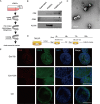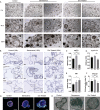Human placenta mesenchymal stem cell-derived exosomes delay H2O2-induced aging in mouse cholangioids
- PMID: 33752720
- PMCID: PMC7983269
- DOI: 10.1186/s13287-021-02271-3
Human placenta mesenchymal stem cell-derived exosomes delay H2O2-induced aging in mouse cholangioids
Abstract
Background: Cholangiocyte senescence is an important pathological process in diseases such as primary sclerosing cholangitis (PSC) and primary biliary cirrhosis (PBC). Stem cell/induced pluripotent stem cell-derived exosomes have shown anti-senescence effects in various diseases. We applied novel organoid culture technology to establish and characterize cholangiocyte organoids (cholangioids) with oxidative stress-induced senescence and then investigated whether human placenta mesenchymal stem cell (hPMSC)-derived exosomes exerted a protective effect in senescent cholangioids.
Methods: We identified the growth characteristics of cholangioids by light microscopy and confocal microscopy. Exosomes were introduced concurrently with H2O2 into the cholangioids. Using immunohistochemistry and immunofluorescence staining analyses, we assessed the expression patterns of the senescence markers p16INK4a, p21WAF1/Cip1, and senescence-associated β-galactosidase (SA-β-gal) and then characterized the mRNA and protein expression levels of chemokines and senescence-associated secretory phenotype (SASP) components.
Results: Well-established cholangioids expressed cholangiocyte-specific markers. Oxidative stress-induced senescence enhanced the expression of the senescence-associated proteins p16INK4a, p21WAF1/Cip1, and SA-β-gal in senescent cholangioids compared with the control group. Treatment with hPMSC-derived exosomes delayed the cholangioid aging progress and reduced the levels of SASP components (i.e., interleukin-6 and chemokine CC ligand 2).
Conclusions: Senescent organoids are a potential novel model for better understanding senescence progression in cholangiocytes. hPMSC-derived exosomes exert protective effects against senescent cholangioids under oxidative stress-induced injury by delaying aging and reducing SASP components, which might have therapeutic potential for PSC or PBC.
Keywords: Cholangiocytes; Exosomes; Organoids; Primary sclerosing cholangitis; Senescence.
Conflict of interest statement
The authors declare no competing interests.
Figures






Similar articles
-
Development and characterization of cholangioids from normal and diseased human cholangiocytes as an in vitro model to study primary sclerosing cholangitis.Lab Invest. 2017 Nov;97(11):1385-1396. doi: 10.1038/labinvest.2017.63. Epub 2017 Sep 11. Lab Invest. 2017. PMID: 28892096 Free PMC article.
-
Genetic or pharmacological reduction of cholangiocyte senescence improves inflammation and fibrosis in the Mdr2 -/- mouse.JHEP Rep. 2021 Jan 27;3(3):100250. doi: 10.1016/j.jhepr.2021.100250. eCollection 2021 Jun. JHEP Rep. 2021. PMID: 33870156 Free PMC article.
-
Induced Pluripotent Stem Cells From Subjects With Primary Sclerosing Cholangitis Develop a Senescence Phenotype Following Biliary Differentiation.Hepatol Commun. 2022 Feb;6(2):345-360. doi: 10.1002/hep4.1809. Epub 2021 Aug 25. Hepatol Commun. 2022. PMID: 34519176 Free PMC article.
-
Cellular senescence in the cholangiopathies.Curr Opin Gastroenterol. 2022 Mar 1;38(2):121-127. doi: 10.1097/MOG.0000000000000805. Curr Opin Gastroenterol. 2022. PMID: 35098933 Free PMC article. Review.
-
Autophagy and senescence in fibrosing cholangiopathies.J Hepatol. 2015 Apr;62(4):934-45. doi: 10.1016/j.jhep.2014.11.027. Epub 2014 Nov 27. J Hepatol. 2015. PMID: 25435435 Review.
Cited by
-
The Influence of Circulating Exosomes Derived From Younger and Older Donors on Hypoxia-Inducible Factor 1 Alpha Gene Expression and P21 Protein in Cord Blood Hematopoietic Stem Cells.J Hematol. 2024 Oct;13(5):192-199. doi: 10.14740/jh1291. Epub 2024 Oct 21. J Hematol. 2024. PMID: 39493603 Free PMC article.
-
The Comparative Effect of Plasma Exosomes of Young and Old People on the Expression of BCL-2 and BAX Genes in Hematopoietic Stem Cells.Indian J Hematol Blood Transfus. 2024 Oct;40(4):647-654. doi: 10.1007/s12288-024-01779-x. Epub 2024 May 1. Indian J Hematol Blood Transfus. 2024. PMID: 39469166
-
MSC-derived exosomes attenuate hepatic fibrosis in primary sclerosing cholangitis through inhibition of Th17 differentiation.Asian J Pharm Sci. 2024 Feb;19(1):100889. doi: 10.1016/j.ajps.2024.100889. Epub 2024 Feb 12. Asian J Pharm Sci. 2024. PMID: 38419761 Free PMC article.
-
Pooled Analysis of Mesenchymal Stromal Cell-Derived Extracellular Vesicle Therapy for Liver Disease in Preclinical Models.J Pers Med. 2023 Feb 28;13(3):441. doi: 10.3390/jpm13030441. J Pers Med. 2023. PMID: 36983624 Free PMC article. Review.
-
Microfluidic Tools for Enhanced Characterization of Therapeutic Stem Cells and Prediction of Their Potential Antimicrobial Secretome.Antibiotics (Basel). 2021 Jun 22;10(7):750. doi: 10.3390/antibiotics10070750. Antibiotics (Basel). 2021. PMID: 34206190 Free PMC article.
References
-
- Campisi J, d’Adda di Fagagna F. Cellular senescence: when bad things happen to good cells. Nat Rev Mol Cell Biol 2007;8(9):729–740, DOI: 10.1038/nrm2233. - PubMed
-
- Pinto C, Giordano DM, Maroni L, Marzioni M. Role of inflammation and proinflammatory cytokines in cholangiocyte pathophysiology. Biochimica et biophysica acta Molecular basis of disease. 2018;1864(4 Pt B):1270–1278. - PubMed
-
- Chung BK, Karlsen TH, Folseraas T. Cholangiocytes in the pathogenesis of primary sclerosing cholangitis and development of cholangiocarcinoma. Biochimica et biophysica acta Molecular basis of disease. 2018;1864(4 Pt B):1390–1400. - PubMed
Publication types
MeSH terms
Substances
LinkOut - more resources
Full Text Sources
Other Literature Sources

